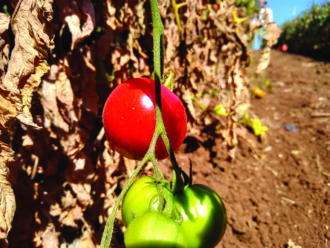Climate change poses a serious challenge to Western farmers. How do you grow crops profitably when rainfall and drought are becoming so unpredictable and extreme?
For many producers, dry farming may offer a way forward. Instead of relying on surface irrigation throughout the summer, dry farmers are finding ways to capture water from winter rains before it flows to the sea and store it in the soil long enough to harvest their crops.
The practice has its challenges. Dry-farmed produce tends to be smaller in size and yield, but the bounty is often longer lasting and exceptionally sweet. Supported by grants from Western Sustainable Agriculture Research and Education, researchers are helping dry farmers clarify which practices can potentially increase crop quality and yield while protecting limited water supplies.
For example, new research from Yvonne Socolar, a Ph.D. candidate from the University of California at Berkely, is shedding light on how dry-farmed crops access nutrients and impact soil health. Socolar recently conducted on-farm trials with six dry-farm tomato growers located near California’s Central Coast.
“Dry farmers are the experts in this system,” Socolar said. “There hasn’t been a lot of research conducted in dry farming with vegetables, so it’s exciting to study some of the issues these innovative farmers have already identified.”
First up: Nutrient depth
In conventional farming, plant roots cluster close to the surface to access water and fertilizer added from above. Dry-farmed crops extend their roots further underground to pull moisture stored deeper in the soil. Can those deep roots benefit from nutrients located in top layers of soil?
Not so much, Socolar concluded. Socolar discovered dry-farm tomatoes draw most nutrients from two-to-three feet underground.
“It was so clear-cut, scientifically,” she said. “We thought young plants might benefit from surface nutrients before they sent roots down to access moisture, but that doesn’t appear to be the case. When farmers are trying to increase quality and yield, nutrients located at least two feet underground are what matter.”
Farmers have various ways to deposit nutrients underground. Growing deep-rooted cover crops like rye and peas is a good way to enrich lower layers of land. Farmers can also plan ahead: The nutrients you add today can show up two feet below the surface in a few years (depending on rainfall or irrigation.)
Tilling is another way to uncover and apply nutrients deep in the soil. But aggressive tilling can disrupt fungal communities and accelerate decomposition of organic matter, which can hinder the soil’s ability to hold water.
Fungal diversity in the field
Healthy soil is alive with billions of bacteria, fungi and other microorganisms that can provide nutrients for plant growth and help store water. Some farmers wonder if they need to invest in fungal inoculants to make sure their soil systems are balanced and running well.
“We discovered that fungal inoculants aren’t necessary to sustain dry-farm tomato performance or soil health,” Socolar said. “In the systems we tested, the fungal community doesn’t benefit from adding external species.”
Socolar analyzed soil samples from dry farms as well as soil from nearby irrigated and non-cultivated land. The dry-farm soil was especially rich in certain fungi that seem to be a signature of low-water farming, and those fungi were associated with higher tomato yields and better fruit quality.
“So, rather than depleting the soil, farming with fewer inputs might actually sustain continued growth in dry-farm systems,” Socolar said. “Perhaps when farming systems best align with the local conditions, it’s good for farming and for the environment.”
Boosting flavor and sustainability
Dry-farmed tomato plants look almost dead by the time the fruit is ripe, but the flavor is remarkable. Less moisture in the soil translates to lower water content, less dilution and more sweetness in the crop. The same is true of other popular dry-farmed crops like potatoes, squash and melons, which are the focus of other SARE-funded projects. Associate Professor Alexandra Stone from Oregon State University, for example, is working with tomato and melon growers in Oregon to expand knowledge and awareness of dry-farming practices among growers and consumers.
As Socolar notes, awareness is the key to farming in the face of climate change.
“It’s a huge challenge for farmers to cope with water scarcity without jeopardizing their livelihoods,” Socolar said. “Dry farming may be one answer. The practices appear to increase produce quality, support economic viability and promote water resilience.”
